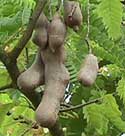| |
Tamarind
tree is the native of Africa and south India.
It grows to the height of 60 to 70 feet
with a broad trunk. It is an ornamental
tree with a longevity of 120 years. The
leaves are one inch long leguminous, half
an inch broad and sour in taste. The flowers
are pinkish-white and sour in taste. |
 |
|
| The
fruit is a legume measuring from 2 to 10 inches
long having a shape of a crescent. It is covered
with a brown color over the green epicarp when
it is tender. As the fruit ripes the covering
becomes hard and brittle and the pulp becomes
dark-maroon having strings of fibres and about
7 to 10 large brown hard seeds. The pulp is sourish-sweet
in taste and emits a typical sour odour. When
the outer covering is dry the fruits are plucked
and the pulp is separated from outer covering,
fibres and seeds. The pink variety is called Lal
imli
|
|
Tamrindus
indica : (B.N.); Imli : (Hindi) |
| Cacsalpiniaceac. |
| Pisces. |
|
| |
| Carbohydrate |
64 g. |
| Protein |
3.2
g. |
| Fat |
0.5 g. |
| Calcium |
168 mg. |
| Vitamin A |
98 I.U. |
| Niacin |
0.7 mg. |
| Vitamin C |
Trace |
| Digesting Time |
3 Hrs |
| Phosphorous |
108 mg. |
| Iron |
108 mg.. |
| CALORIES |
287 |
|
| |
| |
| A tablespoonful fresh
juice of amla gives as much Vitamin C as one gets
by eating any one of the following foods : |
| Oranges |
(medium size
150 g. each) |
9 ½
kg. |
| Guavas |
(medium size 100 g. each) |
2 |
| Grapes |
|
18 |
| Apple |
( medium size 50 g. each)
|
102 |
| Bananas |
(medium size 150 g. each)
|
52 |
| Mangoes |
( medium size 300 g. each)
|
3 |
| Pineapples |
|
1 |
| Cow’s milk |
(milk 200 g. per cup) |
180 cups etc. |
|
| |
